#Industrial Engineering for Self-Improvement
Explore tagged Tumblr posts
Text
Welcome to InspireSpirit with Lety: Sustainable Solutions & Personal Development.
Greetings, wonderful souls! I’m Leticia, but you can call me Lety. I’m beyond thrilled to welcome you to our cozy corner of the internet, “InspireSpirit with Lety,” a space devoted to the seamless blend of sustainable living and personal growth. At InspireSpirit with Lety, we set out on a journey that is as dedicated to nurturing our planet as it is to nurturing our inner selves. It’s a place…

View On WordPress
#AI in Everyday Life#Community Building#Eco-Consciousness#Eco-Friendly Habits#empowerment#environmental awareness#Industrial Engineering for Self-Improvement#Innovative Sustainability#Lifestyle Change#Mindfulness#Nature Lessons#Personal Development#Positive Mindset#Self-Growth Strategies#sustainable living
0 notes
Text
Full disclosure: my partner has been an electric vehicle geek since the early 2000s, and very passionate about environmental and consumerism issues.
One of his first loves, as a teenager, was computer programming.
During the 1998 North American ice storm, while he was still just a student, they came to hire him to develop a system to quickly and effectively keep track of and distribute the relief money to the population.
Since then, he's made a career in programming, and spends a lot of his free time programming from home as a personal hobby of his.
So, when Tesla started making electric vehicles that were a crossover between an electric car and a computer (two of his passions / special interests), he naturally became highly enthusiastic about it!
And I slowly started to share his enthusiasm because I, too, am strongly against consumerism in general.
We will tend to repair home appliances and electronics for as long as we can (until you can no longer purchase repair parts), even when "buying a new one" would be cheaper.
I kept the same cell phone from 2001 to 2016, and I only changed it because the plastic on it was disintegrating and they were planning to stop supporting analog cellular services in our area.
So, what had me incredibly excited about the Tesla Model 3 back then (that was more expensive than any car I ever would have normally considered), was that it was designed to be constantly upgraded (for free, no less!) without needing to buy a new car to keep up with the new technology offered on the more recent models.
With our provincial and federal government subventions, the cheap price of electricity in Quebec, and everything we'd be saving on gas, we decided that the investment would be well worth it.
Back in 2016, we (sadly, very naively) saw Elon Musk as a visionary, an environmentalist, and someone with an interest in forcing the North American market (and the world at large) to slowly evolve towards developing more environmentally sustainable products and technologies.
People often compared him to Tony Stark back then, and we were sincerely fooled into thinking that he actually gave a damn about the future of this planet!
To be clear, we see electric cars as PART OF the solution to help tackle climate change, not THE solution to tackle climate change.
Holding various industries, and the wealthiest among us, more accountable for their pollution is obviously part of it.
And we also need to invest in more effective commuting infrastructures, densification (that allows for more services to be within shorter, often even walkable distance) combined with more affordable housing, etc.
There is plenty to be done to address environmental challenges in ways where it will become easier for individuals to make certain choices that will help reduce their own individual carbon footprint!
But, as long as people will continue to want to own personal cars, regardless of them actually needing to own one or not, we will also need to make sure that the cars that are offered on the market have the least negative impact on the environment as possible.
So, EVs aren't the one and only solution to the issue, but we firmly believe they remain a step in the right direction.
Sadly, there's an awful lot of misinformation about EVs. But they still remain a greener option than ICE (internal combustion engine) vehicles in virtually every possible scenario.
It is especially true in Quebec, where 100% of our provincial electricity production is hydroelectric.
So, anyway, we were looking to acquire an EV at that time, and Tesla was the only company with an EV that was designed to regularly upgrade itself and improve to keep up with newer versions of their vehicles at no additional cost.
When we bought it, we thus made the firm decision to keep the car for as long as its body (essentially, the "casing" of our "computer-car") would hold, even if that was 50+ years!
My partner insisted on getting the full self driving (FSD) feature while it was still at its lowest price, because the whole idea of witnessing a computer system slowly learning how to drive, and being amongst those teaching it how to drive, was utterly fascinating to him.
Therefore, on March 31st, 2016, he spent over 3 hours waiting in the rain outside of the Tesla dealership in Montreal to be amongst the very first people making a reservation for the Tesla Model 3.
We received our car in September 2018, named him (yeah, we gave our car a gender, deal with it!) "Spirit", and he's sincerely been the best car I've ever driven (or been driven by) in my entire life! Especially in our harsh Canadian winters!
It really pains me to say that the product itself is astounding, and has even exceeded our expectations. Because I can't, in good conscience, exactly recommend it to anyone under the current political climate / leadership.
Since September 2018, we've watched Spirit evolve, learn, gain new features, and constantly improve in ways that have been utterly fascinating to experience!
But, since September 2018, we've also sadly had to watch Elon Musk evolve into the worst of what humanity has to offer, in ways that have been utterly terrifying to witness!
He's turned into an ultra rich, dangerous, self-obsessed fascist that's declared some sort of cowardly holy war on some of society's most vulnerable people, and that keeps on threatening everything we love, including fellow members of the LGBTQ+ community, and the freaking environment (the thing we once believed he was looking to save), of all things!
And I have no word to express just how disgusted and sick I felt over that Nazi salute he did.
To be fair, I'm pretty sure the oil companies and many giants from the automotive industries that would rather be selling ICE vehicles than EVs have been backing up Trump's campaign and helping him finance it as well.
But they don't wield the level of influence over social media, nor have the freaking "cult following" that Elon Musk has!
Most CEOs will operate from the shadows to avoid alienating part of their clientele, but Elon apparently just doesn't care about hurting his company and its workers, or destroying the legacy of what they have built for/with Tesla.
It's like he just fell into the manosphere at some point, drank their Kool-Aid, and decided to become their champion while trying to fix "everything wrong with the world" according to their perception of it!
A few of our friends have sold their own Tesla for fear of being associated with the man.
And we are a bit at a loss trying to figure out how to handle the situation ourselves.
Hence why I'm writing this, because it feels like my brain is stuffed, about to freaking explode, and I can't quite think clearly!
I sort of need to get it out of my system, and maybe gather other people's thoughts on this.
First, the car has already been paid in full.
So, we can't "unbuy it" to reclaim the money that we already gave Elon Musk's company.
Of course, we could sell the car to get rid of the risk of accidentally being seen as an "Elon Musk supporter" while driving around (the reason why others have done it)...
...but then, we'd only be putting the car into someone else's hands, not removing it from circulation.
And, perhaps, accidentally rewarding an Elon Musk fan by making it possible for them to buy and own a Tesla that they might not have been able to afford at full price otherwise!
Like seriously, I can't fathom why anyone that doesn't already own a Tesla would want to buy themselves one when they know that they would be investing money into Musk's company and increasing his wealth, unless they really don't care about the political positions / actions of its CEO, and/or they agree with him.
So, selling it would basically just make an Elon Musk supporter happy!
And I'm not exactly into making any Elon Musk fan happy right now.
And, when we bought our car, since we were amongst the first people reserving it by putting a deposit on it 2 years in advance, there was a deal where Tesla would be the one paying for our internet subscription services to allow us to stream music, watch Netflix, YouTube, etc. in the car for free for as long as we remained the owners of the car.
Meaning that we are the ones costing Elon Musk's company money by listening to music and watching movies in our car.
Somehow, watching "Sense8" on Netflix in a Tesla knowing that Elon Musk / Tesla is paying for your internet connection symbolically hits a sweet spot.
That deal isn't transferable if we sell the car, either.
So, the company would just have one less internet subscription to continue paying for.
And, even if we could financially afford to destroy the car, totally remove it from the roads, and donate the battery to a company that recycles them, etc., the car itself is in perfect working condition, and throwing away something that works and will need to be replaced feels like we're once again displacing the issue and wasting resources.
Maybe we could put a sticker such as

on it (source).
But then, my partner fears that we might get attacked by far-right Elon Musk fans/supporters, since they've been known for not exactly being kind to those opposing them.
So yeah, I'm just going crazy right now trying to figure out how to handle being stuck with a car that people tend to so strongly associate with Elon Musk!
It's like...
You buy a car in an effort to do your own personal part for the environment, reduce your own carbon footprint, and fight consumerism in the automotive industry...
Then, 7 years later, the CEO of the company that holds 13% of its shares makes his grand coming out as a Neo-Nazi / Neo-Nazi supporter!

The situation feels a bit surreal, and nothing quite prepares you to mentally and intellectually deal with that!
Current mood:

12 notes
·
View notes
Text

Sir Kenneth Grange
A giant of 20th-century design whose products – from food mixers to lamps and trains – became staples of British life
Kenneth Grange, who has died aged 95, was the leading British product designer of the second half of the 20th century. Even if unaware of his name, most people in Britain are familiar with his output: the Kenwood Chef food mixer, the Kodak Instamatic camera, the Ronson Rio hairdryer, the Morphy Richards iron. These everyday objects are part of all our histories. Grange was also responsible for the restyling of the InterCity 125 high-speed train and the 1997 TX1 version of the London taxi.
He was a tall, handsome, ebullient man, a joker with that element of inner moral purpose often found in the designers of his postwar generation. He grew up imbued with a determination to make the world a better place visually, his emphasis always on functional efficiency. Grange was a master at reassessing usage, but he also viewed design in terms of sheer enjoyment. He wanted us to share in the surprising grace of the experience as the 125 train comes hurtling down the track.
When he set up his own design consultancy in 1956, Grange was one of just a handful of designers operating in the world of what were then quaintly called consumer goods. Many of his early commissions came via the Council of Industrial Design (now the Design Council), a governmental body set up with the remit of improving national design standards. Grange’s commission to design Britain’s first parking meter, the Venner, introduced in 1958, came via the council. So too did his introduction to Kenneth Wood, proprietor of the firm in Woking whose domestic products were marketed as Kenwood. Grange’s clean-lined and user-friendly Kenwood Chef food mixer became a housewives’ status symbol of its time.
Like his near contemporary Vidal Sassoon, Grange came from a non-artistic background and had a similarly innate sense of visual style. Both men were quintessentially 1960s talents, Sassoon with his geometric haircuts, Grange with a succession of urbane modern products for a new, self-consciously fashionable age. He became a prime designer for the growing market in “portable accessories”: pens for Parker, cigarette lighters for Ronson, the melamine and smoked perspex Milward Courier shaver which, in 1963, won the Duke of Edinburgh’s prize for elegant design (now known as the Prince Philip Designers prize). Did Prince Philip himself use it? Grange insisted that he did.
In 1972 Grange joined four of the rising stars of his profession – Alan Fletcher, Colin Forbes, Theo Crosby and Mervyn Kurlansky – in founding the ultra-modern design group Pentagram. This was a multidisciplinary consultancy described by Grange as “a one-stop shop” providing specialist services in graphic design and advertising, architecture and – Grange’s own area – product design.
Pentagram became the bee’s knees of design consultancies: ambitious, professional, intelligent and jaunty. It attracted loyal clients, including Reuters, for whom Grange designed the Reuters monitor, a state-of-the-art computer terminal and keyboard, superbly well engineered in heavy silver aluminium sheet.
Through the 70s Grange was occupied with the most high profile of his design commissions: the aerodynamics, interior layout and exterior shaping of the nose cone of British Rail’s High Speed Train (HST). The InterCity 125 was a key element in BR’s strategy to woo passengers away from cars and planes and back on to the trains. However the first HST prototype they came up with was, in Grange’s opinion, “a lumpish, brutish thing”.
He realised he could only improve the appearance by first tackling the aerodynamics. On his own initiative (and at his own expense) he spent a week at night working with a consultant engineer at Imperial College London, where there was a wind tunnel. In the course of these experiments they developed a number of new ideas, getting rid of the buffers, hiding the couplings in the underside of the nose cone, and giving the train a more futuristic look.
It was launched in 1976 with its radical, dynamically angled nose design. Grange was always careful to give credit to the expertise of the engineers he worked with. All the same, it was his major triumph and a lasting symbol of the best of mid-20th-century British design. The HST – still in use today on selected passenger services after almost 50 years – transformed the public experience of travelling by train.
He was born in east London, the son of Hilda (nee Long), a machinist, and Harry Grange, an East End policeman. Kenneth was brought up in what he once vividly described as “a bacon-and-eggs kind of house”, respectably furnished with a three-piece suite and flowery curtains, the dominant colour being brown. Nevertheless his parents supported his chosen career in what was then termed “commercial art”. During the second world war, the family had moved to Wembley in north London, and Kenneth won a scholarship to Willesden School of Art and Crafts where, from the age of 14, he studied drawing and lettering.
These basic skills gave him the entree to a succession of architects’ offices: Arcon; Bronek Katz and R Vaughan; Gordon and Ursula Bowyer; and, from 1952, the remarkably versatile architect and industrial designer Jack Howe – all of these were modernists and prime movers in the postwar campaign to rebuild Britain using newly available materials and techniques.
Grange took part in the 1951 Festival of Britain, working alongside Gordon and Ursula Bowyer on the Sports Pavilion for the South Bank exhibition. For so many of Grange’s generation of designers – including Sir Terence Conran and my husband, David Mellor – the festival would be a lasting inspiration. As Grange later recollected: “You couldn’t walk a step without seeing something unlikely – the cigar-shaped Skylon, the huge Dome of Discovery, extraordinary metal sculptures, waterfalls that twisted and turned. Nothing was like anything I had ever seen before.”
Where much of British design was still craft-based, dominated by ideas that went back to William Morris, Grange felt the fascination of machine production. He was excited by the sleek designs based on new technology beginning to infiltrate Britain from the US, describing the moulded plastic Eames chair for example as “a rocket ship exploding into our narrow world”. I remember being impressed on my first visit to his house in Hampstead, north London, to find him the possessor of not just one Eames lounge chair but three.
Grange’s natural resilience stood him in good stead through the 70s and 80s, those lean years for designers when British manufacturing lost its way and, as he described it, “unbridled accountancy became the new dynamic in British industry”. He was glad of foreign clients, especially enjoying working in Japan where the innate Japanese awareness of design delighted him. An especially successful commission was a sewing machine designed for the Maruzen Sewing Machine Co in Osaka, to be marketed in Europe. On trips to Japan he started what became a considerable collection of beautiful wooden geisha combs.
Pentagram itself was flourishing, moving in 1984 from Paddington to larger and more stylish premises in a renovated dairy in Notting Hill. At this period it employed more than 80 designers and assistants in different disciplines, and the communal dining room became an ever-welcoming talking shop, a gathering point for London’s design world of the time. I remember some marvellous parties at Pentagram, including the celebration of Grange’s marriage in 1984 to Apryl Swift.
For Grange himself the 1980s brought increasing public recognition. In 1983 a solo exhibition of his work was held at the Boilerhouse at the Victoria and Albert Museum in London.
At this point he was already being lauded as Britain’s most successful product designer. He was made CBE in 1984, and knighted in 2013. In 1985 he received an honorary doctorate from the Royal College of Art and in 1986 became master of the elite group of Royal Designers for Industry. Success never spoilt him. He had a streak of self-denigrating humour and retained a kind of boyish innocence, as if he could hardly believe his good luck.
The sheer challenge of the job had always been his driving force. After his retirement from Pentagram in 1997, after 25 years as a partner, he and Apryl embarked on a project of their own, converting an ancient stone-built barn in the remote countryside near Coryton in Devon into a spectacular modern home with a spiral staircase of highly ingenious modular construction. Completion took five years; Grange commuted weekly between London and Devon, travelling on his familiar High Speed Train.
In 2011 the Design Museum held a retrospective, Kenneth Grange: Making Britain Modern. He continued to design into his 80s. Late commissions included the perfect men’s shirt for the fashion designer Margaret Howell; an updated range of classic lights – the Type 3, Type 75 and, in his 90th year, the Type 80 – for Anglepoise, for whom he had been made design director in 2003; and a really comfortable collection of chairs for elderly people. General levels of design for the aged population made him angry. “Where is the decent modernist care home?” he would ask.
Typical of Grange’s zany 60s humour was his design of a man-shaped timber bookcase that converted to a coffin, the ultimate exercise in recycling. “If I ever pop my clogs, it’s books out and me in, with the lid fixed, up to the great client in the sky.”
Two earlier marriages ended in divorce. Apryl survives him.
🔔 Kenneth Henry Grange, designer, born 17 July 1929; died 21 July 2024
Daily inspiration. Discover more photos at Just for Books…?
10 notes
·
View notes
Text
How AI is Changing Jobs: The Rise of Automation and How to Stay Ahead in 2025
AI and Jobs

Artificial Intelligence (AI) is everywhere. From self-checkout kiosks to AI-powered chatbots handling customer service, it’s changing the way businesses operate. While AI is making things faster and more efficient, it’s also making some jobs disappear. If you’re wondering how this affects you and what you can do about it, keep reading — because the future is already here.
The AI Boom: How It’s Reshaping the Workplace
AI is not just a buzzword anymore; it’s the backbone of modern business. Companies are using AI for automation, decision-making, and customer interactions. But what does that mean for jobs?
AI is Taking Over Repetitive Tasks
Gone are the days when data entry, basic accounting, and customer support relied solely on humans. AI tools like ChatGPT, Jasper, and Midjourney are doing tasks that once required an entire team. This means fewer jobs in these sectors, but also new opportunities elsewhere.
Companies are Hiring Fewer People
With AI handling routine work, businesses don’t need as many employees as before. Hiring freezes, downsizing, and increased automation are making it tougher to land a new job.
AI-Related Jobs are on the Rise
On the flip side, there’s massive demand for AI engineers, data scientists, and automation specialists. Companies need people who can build, maintain, and optimize AI tools.
Trending AI Skills Employers Want:
Machine Learning & Deep Learning
Prompt Engineering
AI-Powered Marketing & SEO
AI in Cybersecurity
Data Science & Analytics
Click Here to Know more
The Decline of Traditional Job Offers
AI is shaking up industries, and some job roles are disappearing faster than expected. Here’s why new job offers are on the decline:
AI-Driven Cost Cutting
Businesses are using AI to reduce operational costs. Instead of hiring new employees, they’re investing in AI-powered solutions that automate tasks at a fraction of the cost.
The Gig Economy is Replacing Full-Time Jobs
Instead of hiring full-time staff, companies are outsourcing work to freelancers and gig workers. This means fewer stable job opportunities but more chances for independent workers.
Economic Uncertainty
The global economy is unpredictable, and businesses are cautious about hiring. With AI improving efficiency, companies are choosing to scale down their workforce.
Click Here to Know more
Preparing for an AI-Driven Future
Feeling worried? Don’t be. AI isn’t just taking jobs — it’s also creating new ones. The key is to stay ahead by learning the right skills and adapting to the changing landscape.
1. Learn AI and Data Analytics
The best way to future-proof your career is to understand AI. Free courses on platforms like Coursera, Udemy, and Khan Academy can get you started.
2. Develop Soft Skills AI Can’t Replace
AI is great at automation, but it lacks emotional intelligence, creativity, and critical thinking. Strengthening these skills can give you an edge.
3. Embrace Remote & Freelance Work
With traditional jobs shrinking, freelancing is a great way to stay flexible. Sites like Upwork, Fiverr, and Toptal have booming demand for AI-related skills.
4. Use AI to Your Advantage
Instead of fearing AI, learn how to use it. AI-powered tools like ChatGPT, Jasper, and Canva can help boost productivity and creativity.
5. Never Stop Learning
Technology evolves fast. Stay updated with new AI trends, attend webinars, and keep improving your skills.
Click Here to Know more
Final Thoughts
AI is here to stay, and it’s changing the job market rapidly. While some traditional roles are disappearing, new opportunities are emerging. The key to surviving (and thriving) in this AI-driven world is adaptability. Keep learning, stay flexible, and embrace AI as a tool — not a threat.
Click Here to Know more
Share this blog if you found it helpful! Let’s spread awareness and help people prepare for the AI revolution.
3 notes
·
View notes
Text
Black inventors

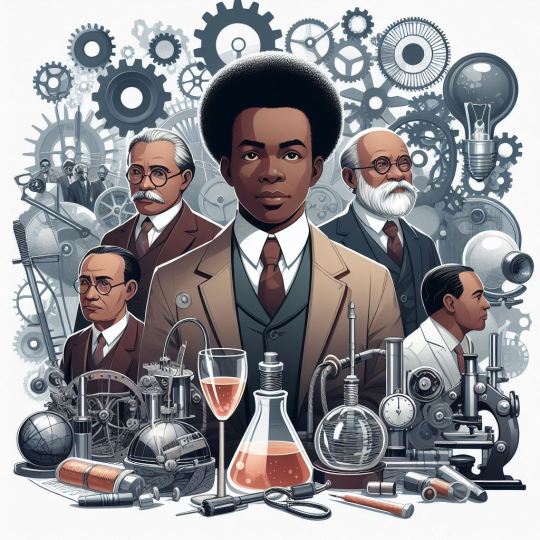
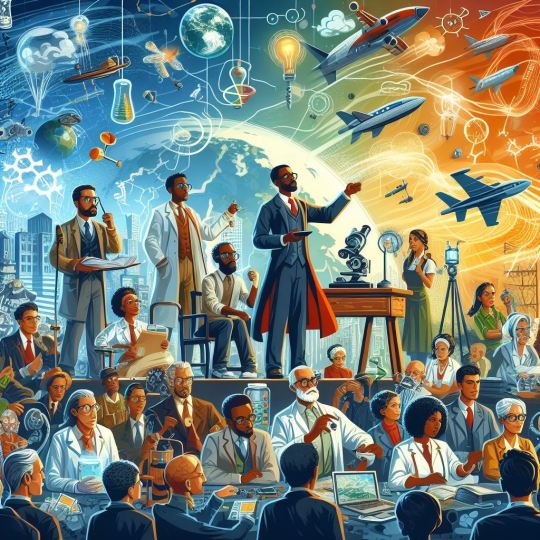


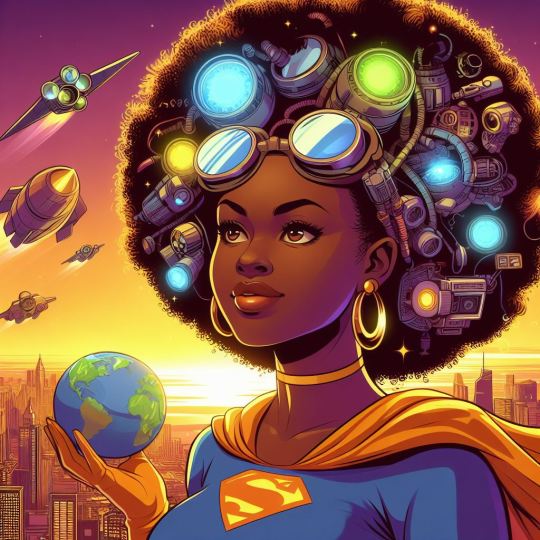

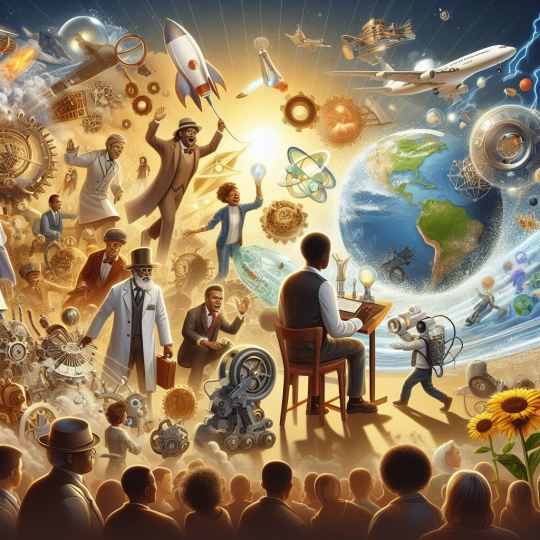


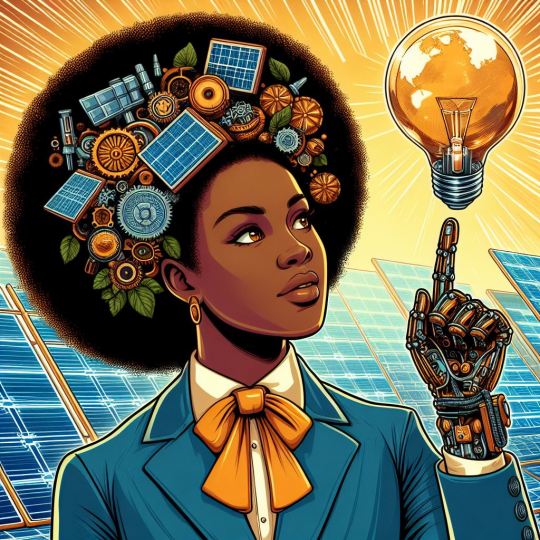

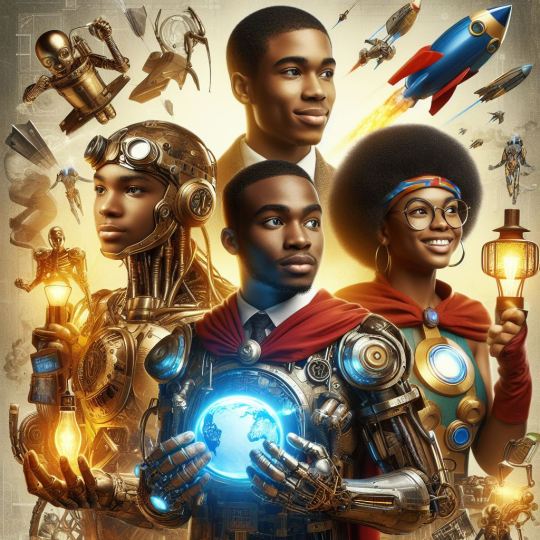
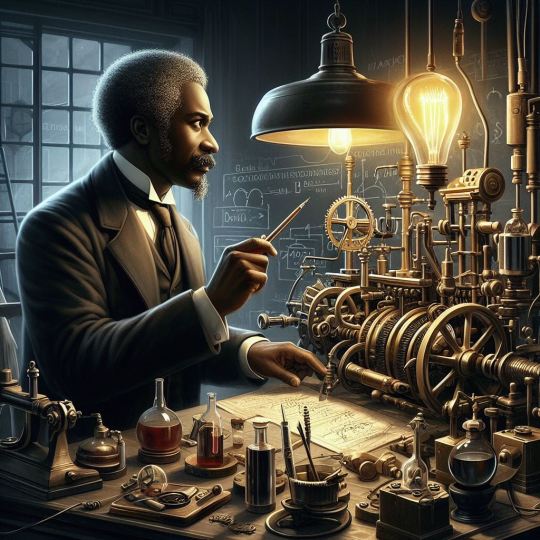
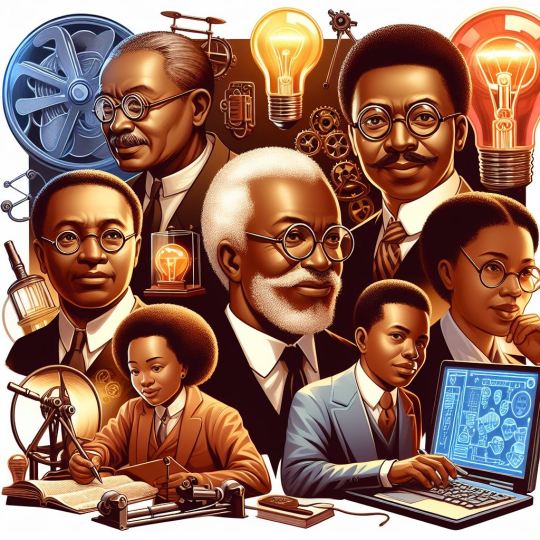
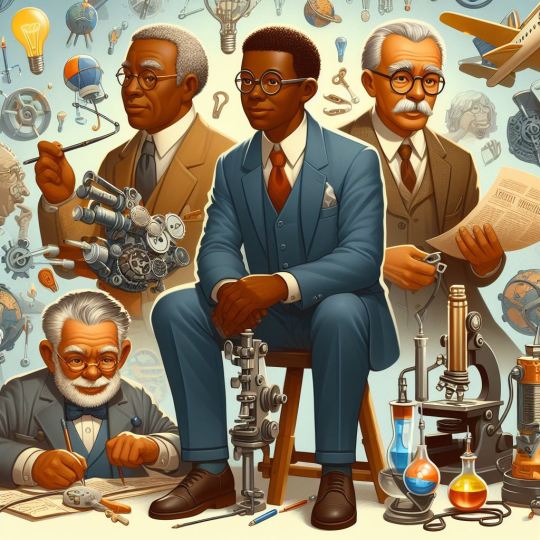
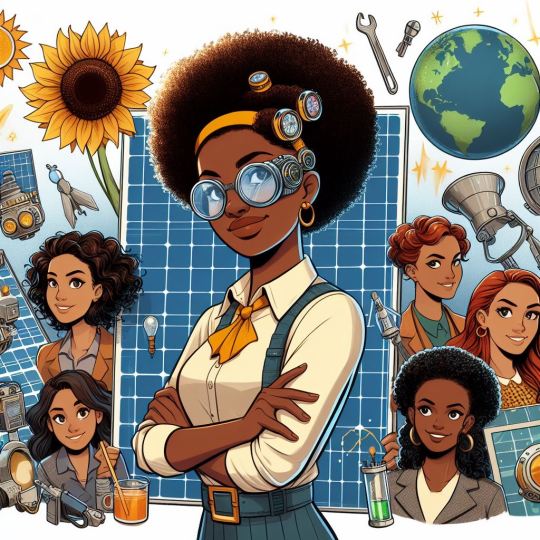


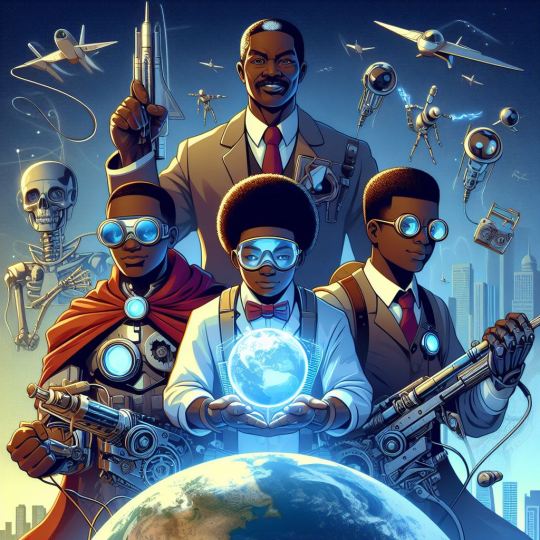
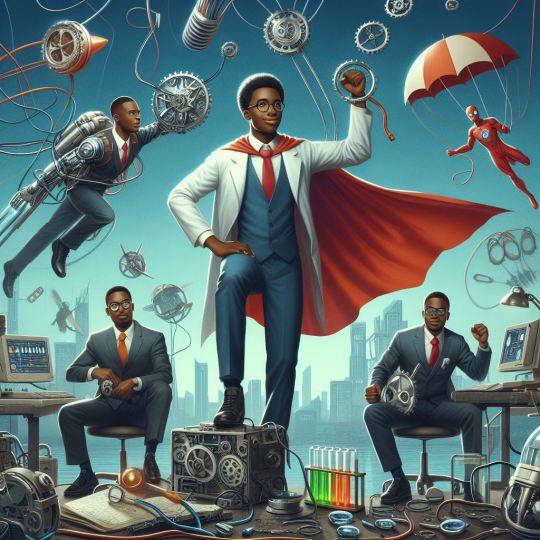


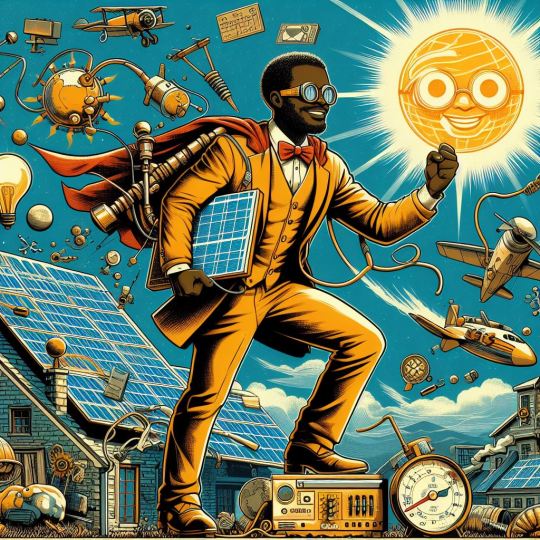
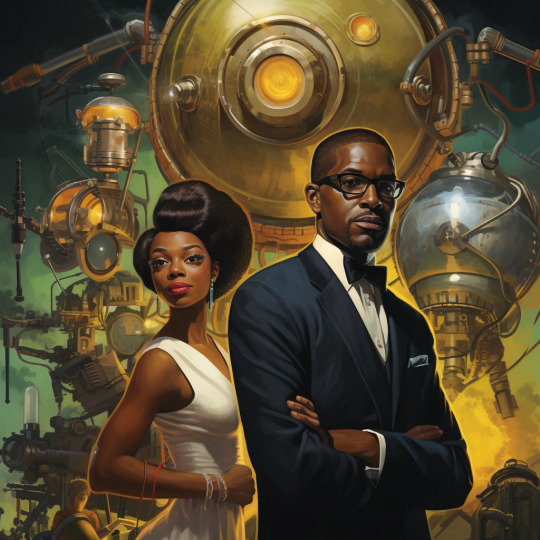
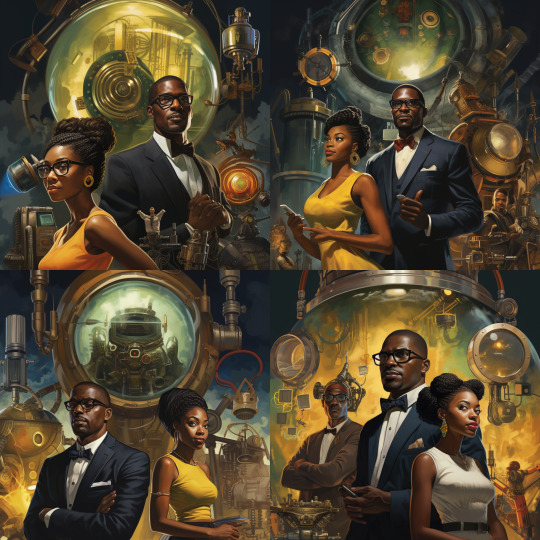
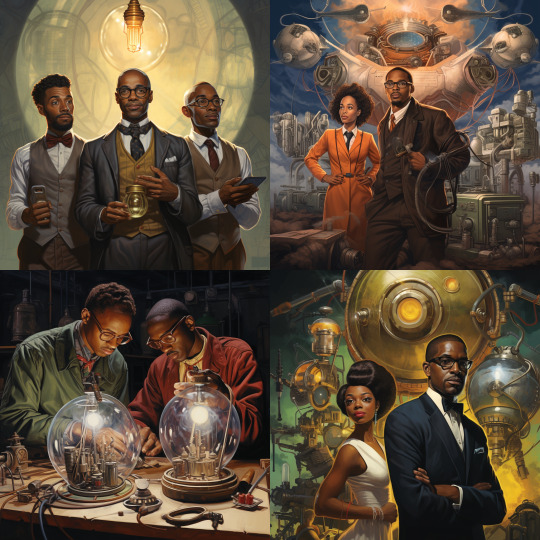


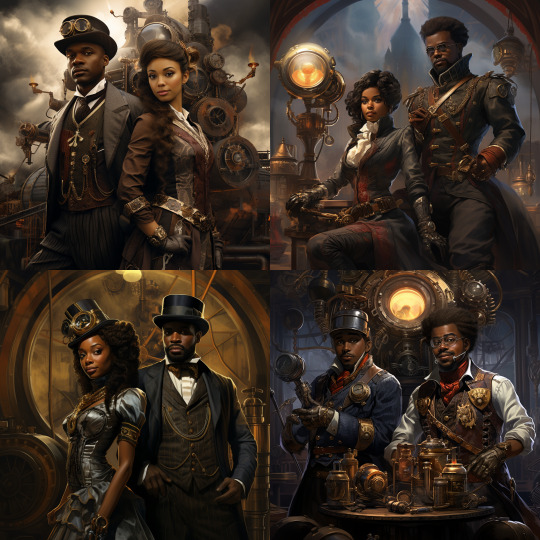
From Perplexity:
Famous black inventors have significantly contributed to various fields, from everyday household items to groundbreaking technological advancements. Here are some notable figures:
George Crum (1824-1914): A chef who is credited with inventing the potato chip in 1853[1].
Frederick McKinley Jones (1893-1961): Developed refrigeration equipment for trucks, trains, ships, and planes, receiving over 40 patents. His invention, the Thermo King, revolutionized the food and medical transport industries[1].
Granville T. Woods (1856-1910): Accumulated almost 60 patents, improving railroad functioning. Notably, he invented the induction telegraph system for train communication[1].
George Washington Carver (1864-1943): An agricultural chemist who developed 518 products from peanuts and sweet potatoes, including ink, dye, soap, and synthetic rubber[1].
Madam C.J. Walker (1867-1919): Became the first African American woman self-made millionaire by creating a line of hair products for African American women[1].
Garrett Morgan (1877-1963): Invented the traffic signal and a safety hood that served as a prototype for the gas mask[1].
Mary Beatrice Davidson Kenner: Patented the sanitary belt in 1957, a significant advancement in women's health and hygiene[1].
Thomas L. Jennings (1791–1859): The first African American to receive a U.S. patent, for a dry-cleaning process[4].
Patricia Bath (1942-2019): Invented a laser cataract treatment, becoming the first African American female doctor to receive a medical patent[4].
Mark Dean (1957-present): Holds over 20 patents, including contributions to the creation of the color PC monitor and the first gigahertz chip[4].
Elijah McCoy (1844-1929): Known for his invention of the automatic lubricator for oiling steam engines, leading to the phrase "the real McCoy" to denote something authentic[4].
These inventors have left a lasting impact on society, demonstrating ingenuity and perseverance in the face of challenges.
Citations: [1] https://www.oprahdaily.com/life/work-money/g30877473/african-american-inventors/ [2] https://www.parents.com/kids/education/world-changing-black-inventors-that-every-kid-should-know-about/ [3] https://www.black-inventor.com [4] https://www.biography.com/inventors/g46697619/famous-black-inventors [5] https://en.wikipedia.org/wiki/List_of_African-American_inventors_and_scientists
From Gemini (formerly Bard):
20 Famous Black Investors with Short Descriptions:
Dr. Shirley Jackson: First Black woman to earn a doctorate in nuclear physics, invested in research and development for the U.S. Department of Defense.
Robert F. Smith: Founded Vista Equity Partners, a private equity firm with over $85 billion in assets under management. Known for his philanthropic endeavors.
Oprah Winfrey: Media mogul and investor, known for her investments in cable channels, production companies, and Weight Watchers.
Udayan I. Lekhraj: Founded CMG Partners, a private equity firm specializing in healthcare investments. Advocate for diversity and inclusion in venture capital.
Catherine Hughes: Founded Urban One, a media company serving the African American community. First Black woman to chair a publicly traded company in the U.S.
Rodney Bryant: Co-founded JUST Capital, a firm that measures and incentivizes corporations to prioritize stakeholder capitalism.
Ellen Johnson Sirleaf: Former President of Liberia, Nobel Peace Prize winner. Focused on economic development and investment in her country.
Ronald Lauder: CEO of Estee Lauder Companies, known for his investments in the beauty industry and philanthropic work.
Charles R. Bronfman: Chairman of The Seagram Company Ltd., invested in various industries including entertainment, real estate, and philanthropy.
John Rogers Jr.: Founded Ariel Investments, a mutual fund company with over $28 billion in assets under management. Advocate for responsible investing.
Marc Morial: Former mayor of New Orleans, currently president of the National Urban League. Focused on economic empowerment of Black communities.
Ronald Watkins: Founding CEO of Watkins Investing Group, invests in real estate and businesses within the Black community.
Melody Hobson: President and CEO of Ariel Investments, known for her work on financial literacy and diversity in boardrooms.
Aisha Evans: Founded BE Capital, a venture capital firm focused on Black and Latinx tech entrepreneurs.
Kevin Hart: Comedian and investor, known for his investments in production companies, streaming platforms, and sports teams.
Jay-Z: Rapper and entrepreneur, known for his investments in music streaming, sports teams, and venture capital funds.
Will Smith: Actor and investor, known for his investments in production companies, media platforms, and venture capital funds.
Serena Williams: Tennis champion and investor, known for her investments in venture capital funds focused on women and diverse founders.
Rihanna: Singer and entrepreneur, known for her investments in beauty brands, fashion lines, and technology startups.
LeBron James: Basketball player and investor, known for his investments in media companies, production companies, and technology startups.
Please note: This list is not exhaustive and can be debated in terms of individual importance and impact.
Reading List on Black Inventors:
Black Inventors: Lives That Mattered by Darlene R. Medford
Hidden Figures: The American Dream and the Untold Story of the Black Women Mathematicians Who Helped Win the Space Race by Margot Lee Shetterly
Lifting the Veil: Celebrating the Unsung Heroes of Black History by Michael Hill
Lost Genius: The Forgotten Black Inventors Who Changed the World by Dennis Freeman
Pioneering Women in American Mathematics: From Agnes Scott to Emmy Noether by Pamela Prochazka
Black Inventors in Science and Technology by Shirley J. Smith
A Colored Man's Reminiscences of James M. Whitfield: With Recollections of the Early Struggles of Colored Men in Boston by Wilbur H. Siebert
Inventing the Future: Black Inventors in Science and Technology by Geneva Gay
African Americans in Science, Math, and Invention by Darlene R. Medford
Black Inventors in the United States by Darlene R. Medford
This list offers a variety of books covering different periods and areas of innovation by Black inventors. Consider exploring further based on your specific interests.
I hope this information is helpful!
#african american history#black history month#black history month 2024#dalle3#midjourney#black inventors#blackhistorymonth#africanamericanhistory#afrofuturism#solar punk#steampunk
18 notes
·
View notes
Text

Transforming Self-Service with Panashi’s Cutting-Edge Kiosk Design! 🚀
At Panashi Technology Solutions, we are redefining self-service with our latest kiosk design, blending innovation, aesthetics and functionality to enhance customer experiences. Our kiosks are engineered to deliver seamless transactions across industries, including banking, HR, insurance and restaurants, ensuring efficiency and convenience at every touchpoint.
🔹 Sleek, modern design – Crafted for an intuitive and engaging user experience 🔹 Advanced technology – High-performance hardware and software integration 🔹 Industry versatility – Customizable solutions tailored to diverse business needs 🔹 Secure & reliable – Built with robust security measures for safe transactions
With our smart self-service solutions, businesses can reduce wait times, improve operational efficiency and enhance customer satisfaction like never before!
#Panashi#KioskTechnology#SelfServiceSolutions#Innovation#BusinessAutomation#SmartKiosks#PanashiKiosk#KioskDesign#TrendingDesign#InnovativeKiosks#RetailDesign#CustomerExperience#DigitalKiosks#UserFriendlyDesign#SmartRetail#DesignTrends#InteractiveKiosks#TechInRetail#KioskSolutions#ModernDesign#BrandExperience#RetailInnovation#DesignInspiration#FutureOfRetail#selfservicekiosk#businesssolution#kiosk#kioskmachine#bankingkiosk#insurancekiosk
2 notes
·
View notes
Text

Single drop of ethanol to revolutionize nanosensor manufacture
Macquarie University engineers have developed a new technique to make the manufacture of nanosensors far less carbon-intensive, much cheaper, more efficient, and more versatile, substantially improving a key process in this trillion-dollar global industry. The team has found a way to treat each sensor using a single drop of ethanol instead of the conventional process that involves heating materials to high temperatures. Their research, published in Advanced Functional Materials, is titled, 'Capillary-driven self-assembled microclusters for highly performing UV detectors.' "Nanosensors are usually made up of billions of nanoparticles deposited onto a small sensor surface—but most of these sensors don't work when first fabricated," says corresponding author Associate Professor Noushin Nasiri, head of the Nanotech Laboratory at Macquarie University's School of Engineering.
Read more.
#Materials Science#Science#Ethanol#Nanotechnology#Sensors#Materials processing#Capillary action#Macquarie University
33 notes
·
View notes
Text
How to Create and Sell Online Courses
The virtual getting to know industry is booming, and if you have know-how or capabilities to percentage, growing and selling online courses can be a profitable opportunity. Platforms like LearnWithChandeep.Com provide super guidance on how to monetize your know-how efficiently. Here’s how you could emerge as a successful path creator and make cash selling online courses.
1. Identify Your Niche and Audience
Before creating a course, determine your niche and target audience. Think approximately:
What talents or knowledge do you own that others would possibly find treasured?
Who will benefit the most from your route?
What trouble does your path clear up
For example, LearnWithChandeep.com offers specialized courses, each catering to a specific audience, such as Faceless Video Mastery Course, Instagram Growth & Monetization, and Business Growth Templates.
2. Plan and Structure Your Course
Once you’ve identified your niche, outline your course content. A successful course typically includes:
Introduction & Learning Objectives: Explain what students will gain.
Step-by-Step Modules: Break down complex topics into easy-to-digest lessons.
Engaging Multimedia: Use videos, PDFs, templates, and quizzes to enhance learning.
Actionable Assignments: Encourage students to apply what they’ve learned.
3. Create High-Quality Content
Course quality is crucial to success. Consider the following:
Video Content: Even if you don’t want to appear on camera, courses like Faceless Video Mastery teach how to create compelling content without showing your face.
Downloadable Resources: Offer worksheets, templates, and guides to add value.
Professional Audio & Visuals: Good lighting and clear audio improve engagement.
4. Choose the Right Platform
Decide where to host your course. You can use:
Self-Hosting: Build a course platform on your own website like LearnWithChandeep.com.
Marketplaces: Sell on platforms like Udemy or Teachable.
Social media & Email Marketing: Promote through Instagram, YouTube, and email lists.
5. Market and Sell Your Course
To maximize sales, you need a strong marketing strategy:
Use social media: Grow an audience and promote your course.
Leverage SEO: Optimize content for search engines.
Offer Discounts & Bonuses: Provide early-bird pricing or bonus content.
Engage with Your Students: Create a community through Q&A sessions or live webinars.
6. Scale and Automate for Passive Income
Once your course gains traction, you can:
Automate sales funnels with ads.
Bundle multiple courses for higher earnings.
Create membership plans for recurring revenue.
Contact Us
For expert guidance on creating and selling online courses, visit LearnWithChandeep.com or contact Sales@learnwithchandeep.com or 995-306-3642.
#Become a successful course creator#Make money selling online courses#Online course business strategies#Course creation for passive income#Best platforms to sell online courses#Step-by-step guide to creating online courses#How to price your online course#How to make faceless videos#Faceless video creation course#YouTube faceless automation course#Passive income with faceless videos
2 notes
·
View notes
Text
Understanding Artificial Intelligence: A Comprehensive Guide
Artificial Intelligence (AI) has become one of the most transformative technologies of our time. From powering smart assistants to enabling self-driving cars, AI is reshaping industries and everyday life. In this comprehensive guide, we will explore what AI is, its evolution, various types, real-world applications, and both its advantages and disadvantages. We will also offer practical tips for embracing AI in a responsible manner—all while adhering to strict publishing and SEO standards and Blogger’s policies.
---
1. Introduction
Artificial Intelligence refers to computer systems designed to perform tasks that typically require human intelligence. These tasks include learning, reasoning, problem-solving, and even understanding natural language. Over the past few decades, advancements in machine learning and deep learning have accelerated AI’s evolution, making it an indispensable tool in multiple domains.
---
2. What Is Artificial Intelligence?
At its core, AI is about creating machines or software that can mimic human cognitive functions. There are several key areas within AI:
Machine Learning (ML): A subset of AI where algorithms improve through experience and data. For example, recommendation systems on streaming platforms learn user preferences over time.
Deep Learning: A branch of ML that utilizes neural networks with many layers to analyze various types of data. This technology is behind image and speech recognition systems.
Natural Language Processing (NLP): Enables computers to understand, interpret, and generate human language. Virtual assistants like Siri and Alexa are prime examples of NLP applications.
---
3. A Brief History and Evolution
The concept of artificial intelligence dates back to the mid-20th century, when pioneers like Alan Turing began to question whether machines could think. Over the years, AI has evolved through several phases:
Early Developments: In the 1950s and 1960s, researchers developed simple algorithms and theories on machine learning.
The AI Winter: Due to high expectations and limited computational power, interest in AI waned during the 1970s and 1980s.
Modern Resurgence: The advent of big data, improved computing power, and new algorithms led to a renaissance in AI research and applications, especially in the last decade.
Source: MIT Technology Review
---
4. Types of AI
Understanding AI involves recognizing its different types, which vary in complexity and capability:
4.1 Narrow AI (Artificial Narrow Intelligence - ANI)
Narrow AI is designed to perform a single task or a limited range of tasks. Examples include:
Voice Assistants: Siri, Google Assistant, and Alexa, which respond to specific commands.
Recommendation Engines: Algorithms used by Netflix or Amazon to suggest products or content.
4.2 General AI (Artificial General Intelligence - AGI)
AGI refers to machines that possess the ability to understand, learn, and apply knowledge across a wide range of tasks—much like a human being. Although AGI remains a theoretical concept, significant research is underway to make it a reality.
4.3 Superintelligent AI (Artificial Superintelligence - ASI)
ASI is a level of AI that surpasses human intelligence in all aspects. While it currently exists only in theory and speculative discussions, its potential implications for society drive both excitement and caution.
Source: Stanford University AI Index
---
5. Real-World Applications of AI
AI is not confined to laboratories—it has found practical applications across various industries:
5.1 Healthcare
Medical Diagnosis: AI systems are now capable of analyzing medical images and predicting diseases such as cancer with high accuracy.
Personalized Treatment: Machine learning models help create personalized treatment plans based on a patient’s genetic makeup and history.
5.2 Automotive Industry
Self-Driving Cars: Companies like Tesla and Waymo are developing autonomous vehicles that rely on AI to navigate roads safely.
Traffic Management: AI-powered systems optimize traffic flow in smart cities, reducing congestion and pollution.
5.3 Finance
Fraud Detection: Banks use AI algorithms to detect unusual patterns that may indicate fraudulent activities.
Algorithmic Trading: AI models analyze vast amounts of financial data to make high-speed trading decisions.
5.4 Entertainment
Content Recommendation: Streaming services use AI to analyze viewing habits and suggest movies or shows.
Game Development: AI enhances gaming experiences by creating more realistic non-player character (NPC) behaviors.
Source: Forbes – AI in Business
---
6. Advantages of AI
AI offers numerous benefits across multiple domains:
Efficiency and Automation: AI automates routine tasks, freeing up human resources for more complex and creative endeavors.
Enhanced Decision Making: AI systems analyze large datasets to provide insights that help in making informed decisions.
Improved Personalization: From personalized marketing to tailored healthcare, AI enhances user experiences by addressing individual needs.
Increased Safety: In sectors like automotive and manufacturing, AI-driven systems contribute to improved safety and accident prevention.
---
7. Disadvantages and Challenges
Despite its many benefits, AI also presents several challenges:
Job Displacement: Automation and AI can lead to job losses in certain sectors, raising concerns about workforce displacement.
Bias and Fairness: AI systems can perpetuate biases present in training data, leading to unfair outcomes in areas like hiring or law enforcement.
Privacy Issues: The use of large datasets often involves sensitive personal information, raising concerns about data privacy and security.
Complexity and Cost: Developing and maintaining AI systems requires significant resources, expertise, and financial investment.
Ethical Concerns: The increasing autonomy of AI systems brings ethical dilemmas, such as accountability for decisions made by machines.
Source: Nature – The Ethics of AI
---
8. Tips for Embracing AI Responsibly
For individuals and organizations looking to harness the power of AI, consider these practical tips:
Invest in Education and Training: Upskill your workforce by offering training in AI and data science to stay competitive.
Prioritize Transparency: Ensure that AI systems are transparent in their operations, especially when making decisions that affect individuals.
Implement Robust Data Security Measures: Protect user data with advanced security protocols to prevent breaches and misuse.
Monitor and Mitigate Bias: Regularly audit AI systems for biases and take corrective measures to ensure fair outcomes.
Stay Informed on Regulatory Changes: Keep abreast of evolving legal and ethical standards surrounding AI to maintain compliance and public trust.
Foster Collaboration: Work with cross-disciplinary teams, including ethicists, data scientists, and industry experts, to create well-rounded AI solutions.
---
9. Future Outlook
The future of AI is both promising and challenging. With continuous advancements in technology, AI is expected to become even more integrated into our daily lives. Innovations such as AGI and even discussions around ASI signal potential breakthroughs that could revolutionize every sector—from education and healthcare to transportation and beyond. However, these advancements must be managed responsibly, balancing innovation with ethical considerations to ensure that AI benefits society as a whole.
---
10. Conclusion
Artificial Intelligence is a dynamic field that continues to evolve, offering incredible opportunities while posing significant challenges. By understanding the various types of AI, its real-world applications, and the associated advantages and disadvantages, we can better prepare for an AI-driven future. Whether you are a business leader, a policymaker, or an enthusiast, staying informed and adopting responsible practices will be key to leveraging AI’s full potential.
As we move forward, it is crucial to strike a balance between technological innovation and ethical responsibility. With proper planning, education, and collaboration, AI can be a force for good, driving progress and improving lives around the globe.
---
References
1. MIT Technology Review – https://www.technologyreview.com/
2. Stanford University AI Index – https://aiindex.stanford.edu/
3. Forbes – https://www.forbes.com/
4. Nature – https://www.nature.com/
---
Meta Description:
Explore our comprehensive 1,000-word guide on Artificial Intelligence, covering its history, types, real-world applications, advantages, disadvantages, and practical tips for responsible adoption. Learn how AI is shaping the future while addressing ethical and operational challenges.
2 notes
·
View notes
Text
The Private Practice Path: Your Guide to Success

Embarking on the path of private practice can be a thrilling yet daunting endeavor. It's a leap of faith, a journey towards independence and realizing your vision of providing exceptional care. This guide will equip you with the knowledge and strategies to navigate this path successfully.
1. Foundational Pillars:
Define Your Niche: Identify your area of expertise and passion. What specific services will you offer? Who is your ideal client? A focused niche will attract the right clientele and streamline your marketing efforts.
Develop Your Brand: Create a strong brand identity that reflects your values and resonates with your target audience. This includes a compelling logo, website, and consistent messaging across all platforms.
Financial Planning: Conduct a thorough financial analysis. Determine your start-up costs, projected revenue, and break-even point. Explore funding options like loans, grants, or investors.
2. Building a Robust Infrastructure:
Secure Office Space: Choose a location that is accessible to your target clients and aligns with your brand image. Consider factors like rent, utilities, and accessibility.
Technology Setup: Invest in reliable technology to support your practice. This includes a robust electronic health record (EHR) system, teletherapy platforms, and secure communication tools.
Legal and Administrative Setup: Obtain necessary licenses and permits. Develop policies and procedures for client intake, billing, and record-keeping.
3. Marketing and Client Acquisition:
Content Marketing: Create valuable content that positions you as an expert in your field. This could include blog posts, articles, videos, or social media posts.
Networking: Attend industry events, join professional organizations, and build relationships with other healthcare providers.
Online Presence: Optimize your website and online profiles (e.g., Google My Business, social media) for search engines and local visibility.
Client Referrals: Cultivate relationships with other professionals who can refer clients to your practice.
4. Providing Exceptional Client Care:
Prioritize Client Relationships: Build strong rapport with your clients by actively listening to their needs and providing personalized care.
Continuous Learning: Stay updated on the latest research, techniques, and best practices in your field. Attend continuing education courses and workshops.
Seek Feedback: Regularly solicit feedback from clients to identify areas for improvement and enhance your services.
5. Navigating Challenges and Achieving Sustainability:
Burnout Prevention: Prioritize self-care by setting boundaries, scheduling breaks, and engaging in activities that bring you joy.
Financial Management: Track your income and expenses carefully. Implement strategies for maximizing revenue and minimizing overhead.
Adaptability and Innovation: Stay flexible and adapt to changing market conditions and client needs. Embrace new technologies and innovative approaches to care delivery.
6. Cultivating a Supportive Community:
Find a Mentor: Seek guidance from experienced private practitioners who can offer advice and support.
Join a Peer Group: Connect with other private practitioners for peer support, collaboration, and problem-solving.
Build a Team: As your practice grows, consider hiring support staff to assist with administrative tasks and client care.
Final Thoughts:
The path to private practice success is a marathon, not a sprint. It requires dedication, perseverance, and a commitment to continuous learning and growth. By following these principles, you can build a thriving practice that provides high-quality care and fulfills your professional and personal aspirations.
2 notes
·
View notes
Text
Indian Army Grows Stronger Under the Leadership of Honorable Modi Ji: Colonel Rajyavardhan Rathore

The Indian Army, one of the world’s most formidable defense forces, has reached new heights under the leadership of Prime Minister Narendra Modi. Spearheaded by strategic reforms, technological advancements, and a renewed focus on self-reliance, India’s defense ecosystem has transformed significantly. Colonel Rajyavardhan Rathore, a decorated ex-army officer and political leader, has praised PM Modi’s unwavering dedication to national security and the welfare of armed forces personnel.
A Renewed Vision for India’s Defense
Under PM Modi’s leadership, a robust vision for a modern, self-reliant Indian Army has been implemented. These efforts ensure not only national security but also elevate India’s stature on the global stage.
Key Transformations in the Indian Army
1. Strengthening Defense Infrastructure
Construction of strategic roads, bridges, and tunnels in border areas, including the iconic Atal Tunnel in Himachal Pradesh.
Enhanced facilities in high-altitude regions like Ladakh to improve operational readiness.
2. Advanced Weaponry and Equipment
Introduction of cutting-edge equipment such as Rafale fighter jets, Apache helicopters, and S-400 missile systems.
Indigenously developed weapons like the Arjun Mark 1A tank and Tejas fighter jets, showcasing India’s engineering prowess.
3. Emphasis on Self-Reliance
The Make in India initiative has bolstered domestic defense manufacturing, reducing dependency on imports.
Partnerships with private industries to develop next-generation military technology.
4. Border Security Enhancements
Deployment of advanced surveillance drones and radars along the borders.
Strengthened patrol and intelligence systems to ensure swift responses to potential threats.
Col Rajyavardhan Rathore’s Insights
Colonel Rathore, a veteran of the armed forces, has highlighted how PM Modi’s leadership has:
Empowered Soldiers: By focusing on their welfare and operational efficiency.
Strengthened India’s Defense Backbone: Through bold initiatives and modernization.
Inspired National Pride: By showcasing India’s military capabilities globally.
Milestones Achieved Under PM Modi’s Leadership
1. Strategic Strikes
Surgical Strikes (2016): A decisive response to cross-border terrorism.
Balakot Airstrike (2019): Demonstrated India’s ability to neutralize threats beyond its borders.
2. Enhanced Global Partnerships
Strengthening military ties with nations like the USA, Russia, and Israel.
Conducting joint exercises to improve interoperability and operational readiness.
3. Welfare Reforms for Soldiers
Implementation of One Rank One Pension (OROP), fulfilling a long-standing demand of ex-servicemen.
Improved healthcare, housing, and education facilities for defense personnel and their families.
Challenges Addressed by the Government
Bridging the technology gap by investing in Artificial Intelligence, cyber defense, and advanced weaponry.
Ensuring logistical support and supply chain resilience in remote and high-altitude areas.
Boosting morale through recognition of soldiers’ contributions and sacrifices.
India’s Position on the Global Stage
With a stronger and more capable Indian Army, the country has solidified its position as a global power. From peacekeeping missions to humanitarian aid, the Indian Army continues to demonstrate its prowess and commitment.
Conclusion
Under the visionary leadership of Prime Minister Narendra Modi, the Indian Army has become a force to reckon with. From modernization to welfare, the reforms have strengthened not just the military but also the nation’s spirit. Leaders like Colonel Rajyavardhan Rathore recognize and celebrate these achievements, emphasizing the importance of a robust and prepared defense force for a secure future.
3 notes
·
View notes
Text
Artificial Intelligence: Transforming the Future of Technology

Introduction: Artificial intelligence (AI) has become increasingly prominent in our everyday lives, revolutionizing the way we interact with technology. From virtual assistants like Siri and Alexa to predictive algorithms used in healthcare and finance, AI is shaping the future of innovation and automation.
Understanding Artificial Intelligence
Artificial intelligence (AI) involves creating computer systems capable of performing tasks that usually require human intelligence, including visual perception, speech recognition, decision-making, and language translation. By utilizing algorithms and machine learning, AI can analyze vast amounts of data and identify patterns to make autonomous decisions.
Applications of Artificial Intelligence
Healthcare: AI is being used to streamline medical processes, diagnose diseases, and personalize patient care.
Finance: Banks and financial institutions are leveraging AI for fraud detection, risk management, and investment strategies.
Retail: AI-powered chatbots and recommendation engines are enhancing customer shopping experiences.
Automotive: Self-driving cars are a prime example of AI technology revolutionizing transportation.
How Artificial Intelligence Works
AI systems are designed to mimic human intelligence by processing large datasets, learning from patterns, and adapting to new information. Machine learning algorithms and neural networks enable AI to continuously improve its performance and make more accurate predictions over time.
Advantages of Artificial Intelligence
Efficiency: AI can automate repetitive tasks, saving time and increasing productivity.
Precision: AI algorithms can analyze data with precision, leading to more accurate predictions and insights.
Personalization: AI can tailor recommendations and services to individual preferences, enhancing the customer experience.
Challenges and Limitations
Ethical Concerns: The use of AI raises ethical questions around data privacy, algorithm bias, and job displacement.
Security Risks: As AI becomes more integrated into critical systems, the risk of cyber attacks and data breaches increases.
Regulatory Compliance: Organizations must adhere to strict regulations and guidelines when implementing AI solutions to ensure transparency and accountability.
Conclusion: As artificial intelligence continues to evolve and expand its capabilities, it is essential for businesses and individuals to adapt to this technological shift. By leveraging AI's potential for innovation and efficiency, we can unlock new possibilities and drive progress in various industries. Embracing artificial intelligence is not just about staying competitive; it is about shaping a future where intelligent machines work hand in hand with humans to create a smarter and more connected world.
Syntax Minds is a training institute located in the Hyderabad. The institute provides various technical courses, typically focusing on software development, web design, and digital marketing. Their curriculum often includes subjects like Java, Python, Full Stack Development, Data Science, Machine Learning, Angular JS , React JS and other tech-related fields.
For the most accurate and up-to-date information, I recommend checking their official website or contacting them directly for details on courses, fees, batch timings, and admission procedures.
If you'd like help with more specific queries about their offerings or services, feel free to ask!
2 notes
·
View notes
Text
Integrated Cluster Development Scheme: A Visionary Initiative by Col Rajyavardhan Rathore
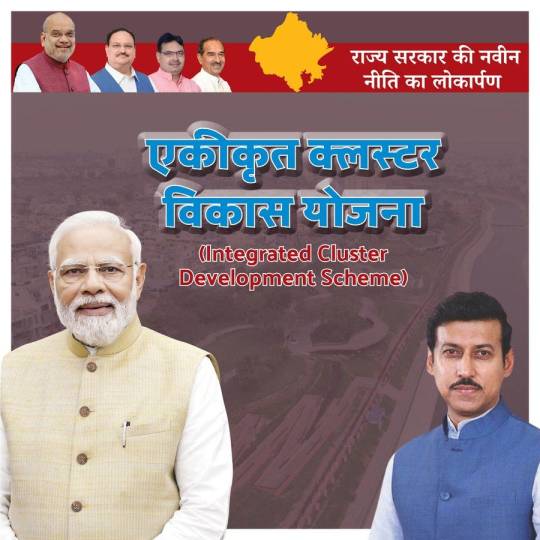
The Integrated Cluster Development Scheme (ICDS), launched under the leadership of Colonel Rajyavardhan Rathore, marks a significant milestone in fostering economic growth and social development across Rajasthan. Focused on empowering small-scale industries, artisans, and rural entrepreneurs, this initiative is set to transform traditional production clusters into engines of innovation, employment, and sustainability.
In this article, we’ll explore the goals, features, and potential impact of this scheme on Rajasthan’s economy and its people.
What is the Integrated Cluster Development Scheme?
The ICDS aims to modernize and strengthen production clusters in Rajasthan, encompassing sectors like handicrafts, textiles, food processing, and small-scale manufacturing. By integrating infrastructure development, skill training, and financial incentives, this scheme provides a holistic framework to promote regional growth.
Col Rajyavardhan Rathore’s Vision Behind the Scheme
Col Rajyavardhan Rathore, a staunch advocate for rural development and economic empowerment, believes that: “Clusters are the backbone of our economy. Strengthening them means empowering our artisans, entrepreneurs, and communities for a brighter, self-reliant Rajasthan.”
His leadership in shaping the scheme reflects a commitment to harnessing the state’s cultural heritage and industrial potential for sustainable development.
Key Objectives of the ICDS
Economic Growth: Enhance the productivity and profitability of Rajasthan’s traditional and emerging clusters.
Job Creation: Generate employment opportunities, particularly in rural and semi-urban areas.
Skill Development: Provide training to workers and entrepreneurs in modern techniques and global standards.
Sustainability: Promote eco-friendly practices in production and infrastructure.
Global Competitiveness: Enable clusters to compete effectively in national and international markets.
Highlights of the Integrated Cluster Development Scheme
1. Infrastructure Upgradation
Establishment of common facility centers (CFCs) equipped with modern tools and machinery.
Development of dedicated industrial parks and cluster zones.
Improved connectivity through roads, railways, and digital infrastructure.
2. Financial Support
Subsidies and Grants: Financial assistance for purchasing equipment and upgrading technology.
Cluster Development Funds: Allocation of funds for infrastructure, marketing, and research.
Low-Interest Loans: Easy access to credit for small businesses and artisans.
3. Capacity Building
Skill Training Programs: Workshops on modern production techniques, quality control, and innovation.
Entrepreneurship Development: Training in business management and digital marketing.
Global Exposure: Participation in national and international trade fairs.
4. Promoting Innovation and Technology
Establishment of innovation hubs within clusters to encourage research and development.
Integration of digital tools such as e-commerce platforms and management software.
5. Focus on Key Sectors
Handicrafts and Textiles: Revitalizing traditional crafts with modern designs.
Food Processing: Expanding the scope of agro-based industries with value addition.
Renewable Energy Clusters: Promoting solar and wind energy production units.
Impact of the Scheme on Rajasthan
Economic Benefits
An estimated 20–30% increase in cluster productivity within the first three years.
Boost in state GDP through enhanced industrial output and exports.
Social Empowerment
Improved livelihood opportunities for over 50,000 workers and artisans.
Empowerment of women and marginalized communities through focused support programs.
Sustainability
Adoption of eco-friendly production techniques, reducing the environmental footprint.
Examples of Targeted Clusters
Jaipur Handicrafts Cluster
Known for its exquisite jewelry, blue pottery, and textiles, Jaipur’s cluster will benefit from marketing support and infrastructure development.
Jodhpur Furniture Cluster
Famous for its wooden furniture, this cluster will see investments in modern tools and export promotion.
Bikaner Agro Cluster
A hub for food processing and agricultural produce, Bikaner’s cluster will receive funding for value-added processing units.
How the Scheme Promotes Self-Reliance
Aligned with the “Make in India” and “Atmanirbhar Bharat” initiatives, the ICDS focuses on reducing import dependency by enhancing local production capabilities. By enabling small businesses to scale up and reach global markets, it fosters a self-reliant ecosystem.
Col Rajyavardhan Rathore’s Commitment to Progress
Col Rathore has been instrumental in advocating policies that blend tradition with technology. His leadership ensures that the ICDS not only preserves Rajasthan’s cultural identity but also propels it into the future.
In his words: “This scheme is a tribute to the hardworking people of Rajasthan who keep our traditions alive while embracing the opportunities of the modern world.”
A New Dawn for Rajasthan’s Clusters
The Integrated Cluster Development Scheme is a game-changer for Rajasthan’s economy. By focusing on modernization, skill enhancement, and financial support, it promises to uplift thousands of artisans, workers, and entrepreneurs while showcasing Rajasthan’s rich heritage to the world.
This initiative is not just about economic development; it’s about empowering communities, celebrating culture, and creating a sustainable future for all.
4 notes
·
View notes
Text
Stanford University A Pillar of Excellence
Stanford University, located in the heart of Silicon Valley, California, is synonymous with instructional excellence, groundbreaking studies, and international impact. As one of the world’s leading establishments, its "outcomes" span various dimensions—instructional achievements, research breakthroughs, societal contributions, and pupil effects. This article delves into the multifaceted outcomes that outline Stanford's unprecedented popularity.

Stanford University Result
Academic Achievements
Stanford continually ranks among the pinnacle universities globally. In the latest rankings with the aid of institutions like QS World University Rankings and Times Higher Education (THE), Stanford has secured pinnacle positions for its academic excellence, innovation, and studies contributions. Notably, Stanford excels in fields such as pc technological know-how, engineering, commercial enterprise, law, and remedy. These results testify to the university’s dedication to fostering highbrow growth and pushing the boundaries of understanding.
Notable Programs
Graduate School of Business: Stanford GSB is renowned for generating leaders in international industries. MBA graduates constantly file for excessive starting salaries and professional delight, reflecting the college’s rigorous curriculum and strong alumni community.
School of Engineering: Often taken into consideration as the backbone of Silicon Valley, Stanford’s engineering programs make contributions notably to technological advancements. Fields like artificial intelligence, bioengineering, and sustainable electricity are key focus areas.
School of Medicine: Stanford Medicine is diagnosed for its modern studies and healthcare innovations, such as contributions to cancer remedies, genomics, and vaccine development.
Results in Rankings
QS Rankings 2024: Stanford is ranked #three globally, highlighting its studies output, educational effect, and agency popularity.
THE Impact Rankings: Stanford ranks the various pinnacle 10 universities for its contributions to the United Nations’ Sustainable Development Goals (SDGs), including great schooling, climate movement, and enterprise innovation.
Research Breakthroughs
Stanford’s reputation as a studies powerhouse is unrivaled. Every 12 months, the university secures billions in study funding from government agencies, private corporations, and philanthropic donors. The effects of this investment take place in improvements that shape industries and enhance lives.
Key Areas of Impact
Artificial Intelligence (AI) and Machine Learning: Stanford researchers have pioneered AI technologies that affect sectors like healthcare, finance, and self-sufficient systems.
Biotechnology: Discoveries in gene modifying, CRISPR generation, and customized remedy underscore Stanford’s role in advancing lifestyles sciences.
Climate and Sustainability: The college’s Stanford Doerr School of Sustainability drives studies in renewable electricity, climate alternate mitigation, and conservation efforts.
Metrics of Success
Research Funding: In 2023, Stanford acquired over $1.Ninety-three billion in subsidized studies investment.
Publications and Citations: Stanford scholars post drastically in high-impact journals, with research mentioned hundreds of thousands of times globally.
Nobel Laureates: Over 20 faculty individuals and alumni have been awarded Nobel Prizes, reflecting the groundbreaking nature of their work.
Entrepreneurial Success
Stanford's entrepreneurial atmosphere is considered one of its maximum amazing outcomes. As the birthplace of companies like Google, Apple, and Tesla, the university fosters a spirit of innovation that extends a long way beyond its campus. Programs just like the Stanford Entrepreneurship Network and access to resources in Silicon Valley offer students and schools unheard-of opportunities to release ventures.
Entrepreneurial Metrics
Startups Founded by Way of Alumni: Over 39,000 agencies had been started out by using Stanford alumni, generating trillions in annual revenue.
Venture Capital Funding: Stanford-affiliated startups entice sizable assignment capital investments, with the college constantly rating as a pinnacle manufacturer of funded marketers.
Economic Impact: Companies founded by Stanford graduates collectively hire hundreds of thousands of human beings internationally, making widespread contributions to the global economy.
Student Success and Satisfaction
The results of Stanford’s educational philosophy are glaring within the achievements of its students and alumni. The college offers a rigorous yet supportive environment that encourages creativity, critical questioning, and interdisciplinary collaboration.
Key Outcomes
Graduation Rates: Stanford boasts a 94% graduation rate, one of the maximum amongst U.S. Universities.
Post-Graduation Employment: A marvelous 91% of graduates steady employment or pursue advanced studies within six months of commencement.
Alumni Impact: Stanford alumni encompass Fortune 500 CEOs, influential policymakers, award-triumphing artists, and leaders in nonprofit sectors.
Enhancing Student Experience
Diversity and Inclusion: Stanford is devoted to constructing a various scholar body, with over 45% of college students figuring out as minorities.
Scholarships and Financial Aid: The college offers a need-primarily based resource to over 70% of students, ensuring get right of entry schooling for talented individuals no matter their economic historical past.
Global Opportunities: Programs just like the Bing Overseas Studies Program permit students to gain global exposure, getting ready them for international careers.
Contributions to Society
Stanford’s impact extends beyond academia and enterprise; its results resonate globally via tasks aimed at addressing societal challenges.
Social and Environmental Impact
Sustainability Efforts: Stanford’s campus is a model of sustainable layout, presenting initiatives to reduce carbon emissions, conserve water, and sell green power.
Public Policy Influence: Stanford’s Hoover Institution and Freeman Spogli Institute for International Studies produce studies that shape public policy on problems like cybersecurity, global health, and governance.
Community Engagement: Through carrier-learning programs and volunteer tasks, Stanford college students contribute lots of hours annually to local and worldwide groups.
Measuring Broader Impact
SDG Contributions: Stanford ranks exceedingly in metrics related to health, training, and innovation, reflecting its alignment with global desires.
Partnerships and Collaborations: The university collaborates with companies like the World Health Organization (WHO), the United Nations (UN), and main nonprofits to cope with urgent international demands.
Challenges and Areas for Growth
While Stanford’s results are overwhelmingly wonderful, the university acknowledges demanding situations and areas for improvement. These include:
Affordability and Accessibility: Despite its beneficent economic aid packages, Stanford faces complaints for its excessive training charges.
Mental Health Resources: As with many elite establishments, the pressures of educational existence can affect scholar well-being, prompting calls for more desirable support offerings.
Sustainability Goals: While Stanford leads in sustainability, reaching carbon neutrality via 2050 stays a protracted-time period venture.
2 notes
·
View notes
Text











Finnish Army WW2 Light Tanks
One Of My Patron Request and Also Part Of Great Projects about Weapons and Heavy Machinery That Used During Winter War (1939-1940) & Continuation War (1941-1944) About The Finland Wars Against Soviet During during early and later Stages Of World War 2. For Your Informations Finnish Army During WW2 Heavy Machinery During Winter Wars Are Rely On Captured Soviets Tanks, Obsolete WW1 Products Or Licensed Products From Allied Countries Disclaimer:Due Heavy Censorship Regarding Swastika Usage in Western Society, The Details of The Tanks Are Replaced With Roundel Instead of Finnish Hakaristi. However It Just A Minor Details that May Missed.
DOWNLOAD Support Me In Patreon for Exclusive Business Agreement Or Support Me In Paypal For One-Time Support
BT-5 Light Tank The BT tanks (Russian: Быстроходный танк/БТ, romanized: Bystrokhodnyy tank, lit. "fast moving tank" or "high-speed tank") were a series of Soviet light tanks produced in large numbers between 1932 and 1941. They were lightly armoured, but reasonably well-armed for their time, and had the best mobility of all contemporary tanks. The BT tanks were known by the nickname Betka from the acronym, or its diminutive Betushka. The successor of the BT tanks was the famous T-34 medium tank, introduced in 1940, which would replace all of the Soviet fast tanks, infantry tanks, and medium tanks in service.
This Particular Variant is BT-5: Armed larger cylindrical turret, 45 mm 20-K gun, coaxial DT machine gun. Earlier tanks used simpler fully cylindrical bolted turrets with rear bustle welded on.
BT-42 Light Tank During the WWII, the Finnish Army utilized captured Soviet tanks as their significant armament. Among these was the BT-42 assault gun which the Finnish Army created by pairing the hull from a captured Russian BT-7 Model 1937 light tank with a British 114mm howitzer and a redesigned BT-7's large boxy turret. 18 units were produced from 1943 to 1944 and they were deployed to the Svir River region to attack the Russian bastion. In June 1944 during the Battle of Vyborg, BT-42s saw fierce combat against advancing Russian forces.
Renault FT-17 Light Tank
The Renault FT (frequently referred to in post-World War I literature as the FT-17, FT17, or similar) was a French light tank that was among the most revolutionary and influential tank designs in history. The FT was the first production tank to have its armament within a fully rotating turret. The Renault FT's configuration (crew compartment at the front, engine compartment at the back, and main armament in a revolving turret) became and remains the standard tank layout. Consequently, some armoured warfare historians have called the Renault FT the world's first modern tank. Over 3,000 Renault FT tanks were manufactured by French industry, most of them in 1918. After World War I, FT tanks were exported in large numbers. Copies and derivative designs were manufactured in the United States (M1917 light tank), in Italy (Fiat 3000) and in the Soviet Union (T-18 tank). The Renault FT saw combat during the interwar conflicts around the world, but was considered obsolete at the outbreak of World War II.
This Model Armed with Puteaux SA 1918 37 mm gun While The Other , Equipped With 8mm Hotchkiss Mle 1914 Machine gun for Anti-Personnel Purpose (Not Showed in Review)
KhT-130
KhT-130 is Flamethrower variant of model 1933 which is Variant Of Soviet T-26 Tank, The Most Successful and Most Modular Pre-WW2 Light Tanks using a larger 45 mm gun turret (a gun was replaced with a flamethrower for Anti-Personnel Purpose).
Landsverk L-62 Anti II
Landsverk L-62, also known as Landsverk Anti II or a combination of both, Landsverk L-62 Anti II, was a Swedish self-propelled anti-aircraft gun construction that was specifically designed for Finland by Landsverk between 1941 and 1942.
The vehicle was an improved Landsverk L-62 Anti I where the turret and chassis had been improved for better protection. The chassis was based on the Landsverk L-60 tank but was lengthened with one extra roadwheel per side. The turret was circular and open for a better view against planes. The gun was a 40 mm Bofors L/60 anti-air gun which was already in service with the Finnish military as the 40 ItK/38.
Vickers Mark E
The Vickers 6-ton tank or Vickers Mark E, also known as the "Six-tonner" was a British light tank designed as a private project at Vickers. It was not adopted by the British Army, but was picked up by many foreign armed forces. It was licensed by the Soviet Union as the T-26. It was also the direct predecessor of the Polish 7TP tank.
Hotchkiss H39 Light Tank (German:PzKpfw 38H-735)
The Hotchkiss H39 (a variant of the Hotchkiss H35) was captured and used by Germany as the PzKpfw 38H-735.
The Hotchkiss H35, or Char léger modèle 1935 H, was a French light tank developed prior to World War II. Despite having been designed from 1933 as a rather slow, but well-armored, light infantry support tank, the type was initially rejected by the French Infantry because it proved difficult to steer while driving cross-country, and was instead adopted in 1936 by the French Cavalry. In 1938, an improved version was produced with a stronger engine, the Char léger modèle 1935 H modifié 39, that from 1940 was also fitted with a longer, more powerful 37 mm gun. It was intended to make this improved variant the standard light tank, and was to be produced in a number of at least four thousand in order to equip new armored divisions of both the Cavalry and the Infantry. However, due to the defeat of France in June 1940, total production of both subtypes remained limited to about 1200 vehicles. For the remainder of the war, Germany and its allies would use captured Hotchkiss tanks in several modifications.
Hotchkiss H39 Light Tank (German:Panzerkampfwagen 38H 735(f))
Variants of A Captured Hotchkiss H39 Tank by German, Outfitted with Nebelwerfer 42, A 30mm German Rockets.
Soviet T-50
The T-50 was a light infantry tank built by the Soviet Union at the beginning of World War II. The design for this vehicle had some advanced features, but was complicated and expensive, and only a short production run of 69 tanks was completed.
Soviet T-26
The T-26 tank was a Soviet light infantry tank used during many conflicts of the 1930s as well as during World War II. It was a development of the British Vickers 6-Ton tank and is widely considered one of the most successful tank designs of the 1930s. It was produced in greater numbers than any other tank of the period, with more than 11,000 produced. During the 1930s, the USSR developed approximately 53 variants of the T-26, including other combat vehicles based on its chassis. Twenty-three of these were mass-produced. The T-26 was used extensively in the armies of Spain, China and Turkey. In addition, captured T-26 light tanks were used by the Finnish, German, Romanian and Hungarian armies. Though nearly obsolete by the beginning of World War II, the T-26 was the most important tank of the Spanish Civil War and played a significant role during the Battle of Lake Khasan in 1938 as well as in the Winter War in 1939-40. The T-26 was the most numerous tank in the Red Army's armored force during the German invasion of the Soviet Union in June 1941. The Soviet T-26 light tanks last saw use in August 1945, in Manchuria. The T-26 was reliable and simple to maintain, and its design was continually modernized between 1931 and 1941, with a total of 11,218 vehicles built. However, no new models of the T-26 were developed after 1940.
Soviet T-26E
Variant Of Soviet T-26 tank with additional armour plating (appliqué armour). Some modern sources mention this tank as T-26E (E stands for ekranirovanny or "screened"). The Factory No. 174 developed the design of 30–40 mm appliqué armour for all types of single-turreted T-26s during the Winter War. On 30 December 1939, factory tests proved that the T-26 with appliqué armour successfully resisted fire from a 45 mm anti-tank gun at a range from 400 to 500 m. Side and front armoured plates were mounted with the use of blunt bolts and electric welding. Toward the middle of February 1940, the RKKA received 27 screened T-26 mod. 1939 tanks and 27 KhT-133 flame-throwing tanks; an additional 15 T-26 mod. 1939 tanks were armoured by workshops of the 8th Army in Suoyarvi in the beginning of March 1940. All in all, 69 T-26s with appliqué armour were used during the Winter War and 20 more were delivered to tank units after the end of the war. Combat use proved that Finnish light anti-tank guns could not penetrate the armour of these tanks.
#the sims 4#the sims#the sims 4 custom content#ts4 cc#ts4military#the sims 4 military#ts4#the sim#the sims 4 cc#ts4cc#finland#soviet union#winter war#the sims 4 decades challenge#ts4 decades challenge#the sims 4 decor#russian tanks#Tanks#the sims 4 build#sims 4 decades#decades challenge#1930s#1940s#Sims 4 war#world war 2#the sims 4 ww2#ww2#light tank
45 notes
·
View notes
Text

I.8.8 But did the Spanish collectives innovate?
Yes. In contradiction to the old capitalist claim that no one will innovate unless private property exists, the workers and peasants exhibited much more incentive and creativity under libertarian socialism than they had under the private enterprise system. This is apparent from Gaston Leval’s description of the results of collectivisation in Cargagente in the southern part of the province of Valencia:
“The climate of the region is particularly suited for the cultivation of oranges … All of the socialised land, without exception, is cultivated with infinite care. The orchards are thoroughly weeded. To assure that the trees will get all the nourishment needed, the peasants are incessantly cleaning the soil. ‘Before,’ they told me with pride, ‘all this belonged to the rich and was worked by miserably paid labourers. The land was neglected and the owners had to buy immense quantities of chemical fertilisers, although they could have gotten much better yields by cleaning the soil …’ With pride, they showed me trees that had been grafted to produce better fruit. “In many places I observed plants growing in the shade of the orange trees. ‘What is this?,’ I asked. I learned that the Levant peasants (famous for their ingenuity) have abundantly planted potatoes among the orange groves. The peasants demonstrate more intelligence than all the bureaucrats in the Ministry of Agriculture combined. They do more than just plant potatoes. Throughout the whole region of the Levant, wherever the soil is suitable, they grow crops. They take advantage of the four month [fallow period] in the rice fields. Had the Minister of Agriculture followed the example of these peasants throughout the Republican zone, the bread shortage problem would have been overcome in a few months.” [Anarchist Collectives, p. 153]
This is just one from a multitude of examples presented in the accounts of both the industrial and rural collectives. We have already noted some examples of the improvements in efficiency realised by collectivisation during the Spanish Revolution (section I.4.10). Another example was the baking industry. Souchy reported that, ”[a]s in the rest of Spain, Barcelona’s bread and cakes were baked mostly at night in hundreds of small bakeries. Most of them were in damp, gloomy cellars infested with roaches and rodents. All these bakeries were shut down. More and better bread and cake were baked in new bakeries equipped with new modern ovens and other equipment.” [Op. Cit., p. 82] In Granollers, the syndicate “was at all times a prime-mover. All kinds of initiatives tending to improve the operation and structure of the local economy could be attributed to it.” The collectivised hairdressing, shoe-making, wood-working and engineering industries were all improved, with small, unhealthy and inefficient workplaces closed and replaced by larger, more pleasant and efficient establishments. “Socialisation went hand in hand with rationalisation.” [Gaston Leval, Collectives in the Spanish Revolution, p. 287] For more see sectionI.8.6 as well as section C.2.8 (in which we present more examples when refuting the charge that workers’ control would stifle innovation).
The substantial evidence available, of which these examples are but a small number, proves that the membership of the collectives showed a keen awareness of the importance of investment and innovation in order to increase production, to make work both lighter and more interesting and that the collectives allowed that awareness to be expressed freely. The collectives indicate that, given the chance, everyone will take an interest in their own affairs and express a desire to use their minds to improve their lives and surroundings. In fact, capitalism distorts what innovation exists under hierarchy by channelling it purely into how to save money and maximise investor profit, ignoring other, more important, issues. As Gaston Leval suggested, self-management encouraged innovation:
“The theoreticians and partisans of the liberal economy affirm that competition stimulates initiative and, consequently, the creative spirit and invention without which it remains dormant. Numerous observations made by the writer in the Collectives, factories and socialised workshops permit him to take quite the opposite view. For in a Collective, in a grouping where each individual is stimulated by the wish to be of service to his fellow beings, research, the desire for technical perfection and so on are also stimulated. But they also have as a consequence that other individuals join those who were first to get together. Furthermore, when, in present society, an individualist inventor discovers something, it is used only by the capitalist or the individual employing him, whereas in the case of an inventor living in a community not only is his discovery taken up and developed by others, but is immediately applied for the common good. I am convinced that this superiority would very soon manifest itself in a socialised society.” [Op. Cit., p. 347]
Therefore the actual experiences of self-management in Spain supports the points made in section I.4.11. Freed from hierarchy, individuals will creatively interact with the world to improve their circumstances. For the human mind is an active agent and unless crushed by authority it can no more stop thinking and acting than the Earth can stop revolving round the Sun. In addition, the Collectives indicate that self-management allows ideas to be enriched by discussion.
The experience of self-management proved Bakunin’s point that society is collectively more intelligent than even the most intelligent individual simply because of the wealth of viewpoints, experience and thoughts contained there. Capitalism impoverishes individuals and society by its artificial boundaries and authority structures.
#anarchist society#practical#practical anarchism#practical anarchy#faq#anarchy faq#revolution#anarchism#daily posts#communism#anti capitalist#anti capitalism#late stage capitalism#organization#grassroots#grass roots#anarchists#libraries#leftism#social issues#economy#economics#climate change#climate crisis#climate#ecology#anarchy works#environmentalism#environment#solarpunk
6 notes
·
View notes